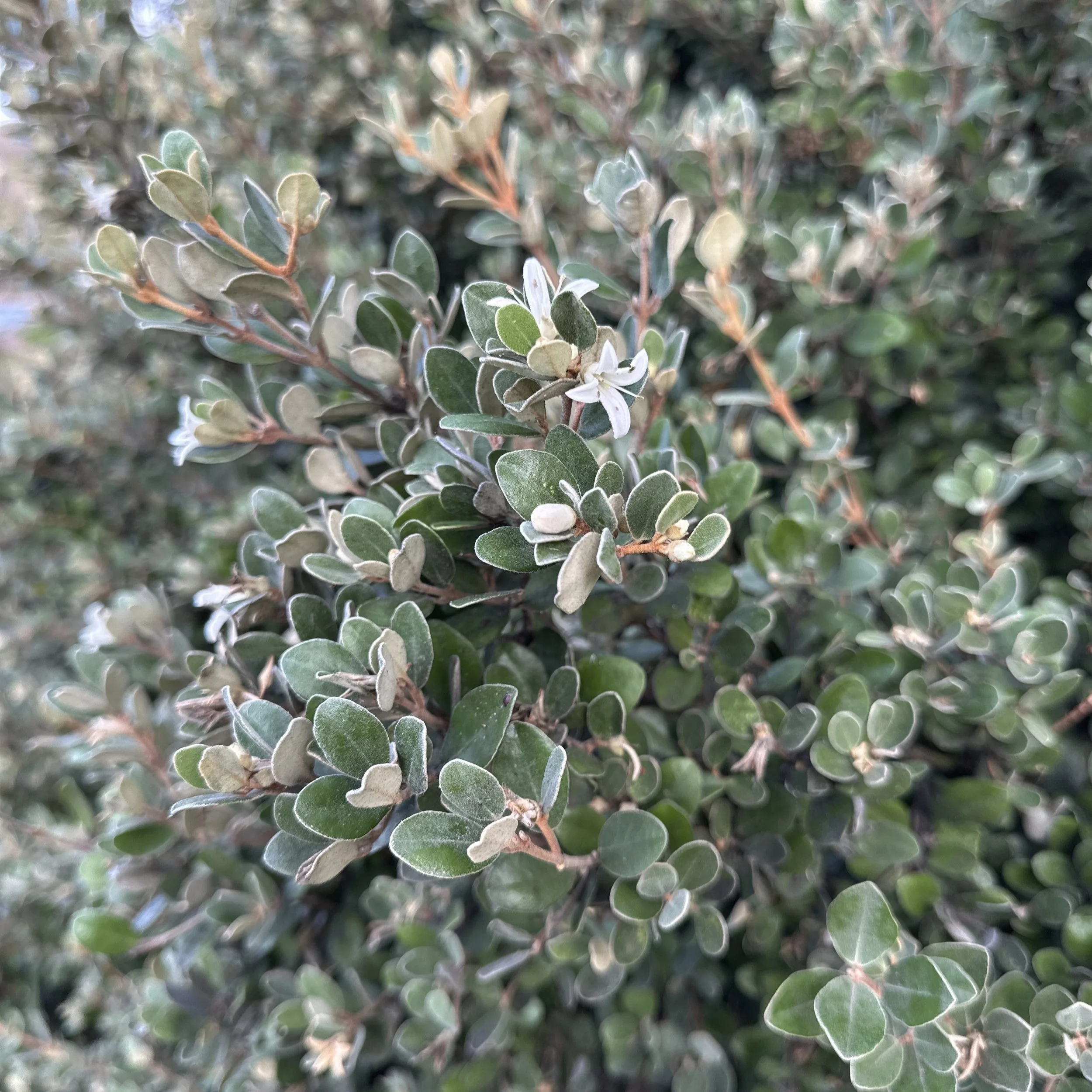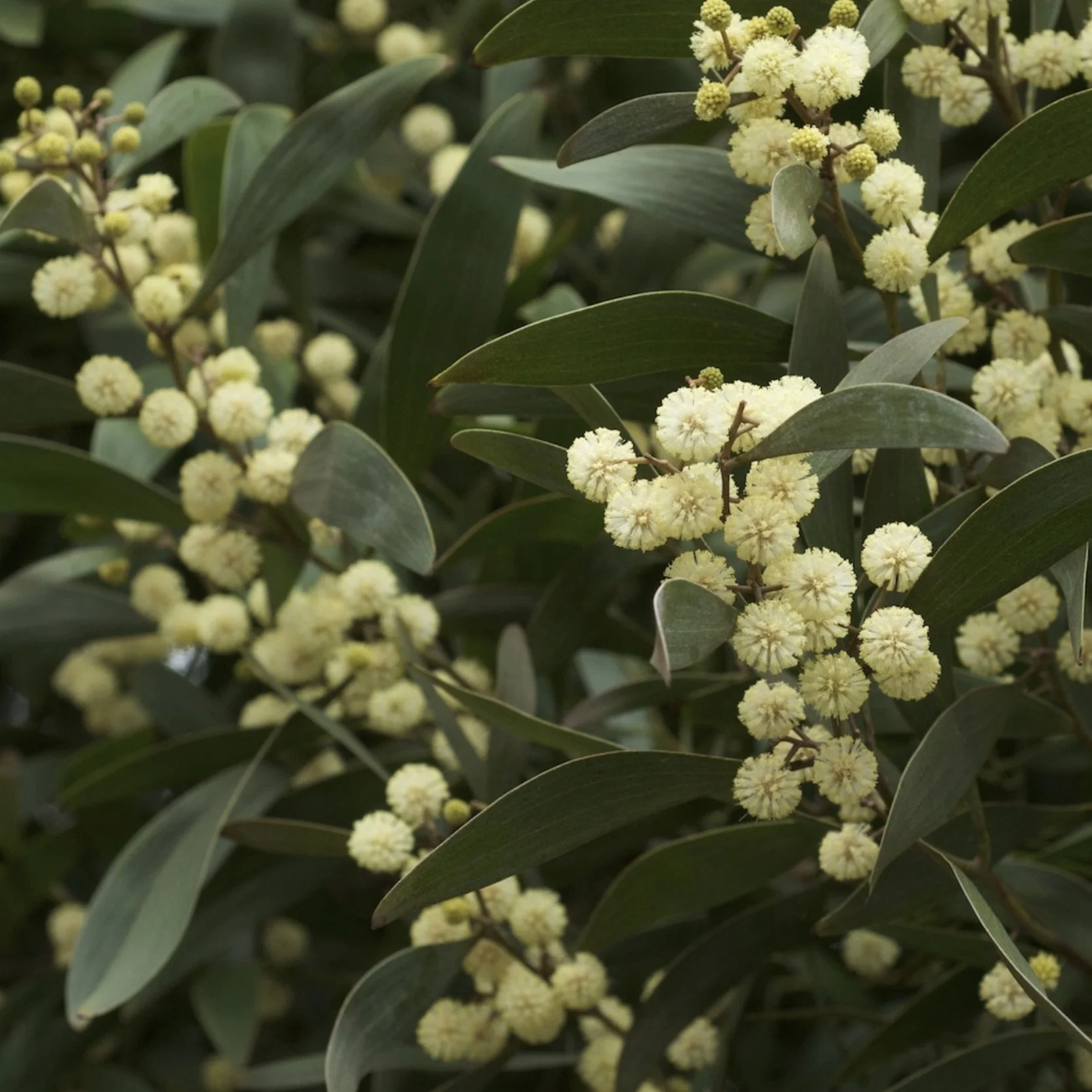Taroona’s Native Plants
Beautiful, Edible & Easy to Propagate
WARNING: DO NOT CONSUME PLANTS UNLESS YOU KNOW HOW TO IDENTIFY PLANTS CORRECTLY.
REFERENCES: ‘Eat Wild Tasmania’ (Rees Campbell) and Trish Hodge, Nita Education (muwinina use).
Native pig face
Carpobrotus rossii
Groundcover with succulent, drought-resistant leaves. Magenta-pink flowers all year, depending on location (sunnier spot = more flowers).
Spreads to many square metres – cut back as needed. Great to use as a weed suppressant instead of bark chip (which is flammable). Good soil-binding agent in exposed coastal places. Happy in sandy and clay soil. Propagate from cutting. Very high strike rate.
Muwinina use
A valuable food plant known as wendar. In dry, lean times Aboriginal people camped close to pigface. Fleshy, salty-sweet purple-pink fruits are delicious (fig/strawberry/kiwi fruit flavour). Fleshy, salty leaves can be cooked and eaten (steamed/sautéed). Juice from leaves used to soothe insect bites and blisters. Poultice of crushed leaves eases burn pain.
Habitat value
Shelters many small animals, including skinks, and provides food for birds. In some areas, ground-nesting coastal birds nest amongst pigface.
Bower Spinach
Tetragonia implexicoma
Performance
Soft ground cover or scrambling climber with succulent leaves, yellow flowers and orange-red berries. Spreads to about a metre. Pioneer plant in dry disturbed sites, where it readily and quickly spreads. Fire retardant – use in place of bark chip as weed suppressant. Propagate from cutting - strikes easily.
Muwinina use
Orange-red berries valued as a red dye and a sweet snack (salty-sweet flavour).
Habitat value
Good shelter for penguins, skinks and invertebrates; berries eaten by birds.
Other highlights
Leaves can be eaten raw or steamed. Try leaves in salads, steamed as a vegetable or as a substitute in spinach pie. Blanch briefly before serving or cooking. Flavour and texture is similar to spinach (hence its common name).
Sagg
Lomandra longifolia
Sedge - 1m x 1m
Looks great as a massed planting. Grows well in wet and dry conditions (prefers drier). Yellow flower spikes in spring. Propagate by division.
Young white shoots (base of new growing rushes) can be eaten raw or baked. Most succulent leaf bases are in centre of tussock. Pull up leaf and peel back to reveal white base. Discard rest of leaf. Tastes a little like green peas. Can use raw in salads, steamed or baked. Great in a vege stirfry, added last and stirred through.
White correa
Correa alba
Hardy, spreading shrub to 1.5m high. Tip prune when young if you want a compact shape. Great pruned to a hedge. White tube flowers mainly in Autumn and Winter. Copes well with sandy and clay soils. Tolerates full coastal exposure. Propagate from cutting.
Muwinina use
Leaves infused for a tea. Early settlers called it ‘island tea’. Make sure you wash and dry leaves carefully before use to remove any sooty mould or sand/dust.
Habitat value
Attracts insects and small birds. Provides dense cover for small mammals, like bandicoots.
Seaberry saltbush
Rhagodia candolleana
Small spreading shrub - 1m high x 2m wide. Succulent grey-green foliage with red berries. Great hedging plant. Likes full sun to part shade; prefers well-drained drier soils.
Eat leaves raw or cooked (taste grassy). High in salt so eat small amounts unless boiled, rinsed and re-boiled to remove excess salt.
Good with scrambled eggs and frittata. Berries bitter but edible. Can be dried or frozen to use later. Can use berries and leaves to make salsa.
Propagate from cuttings or seed.
Grey saltbush
Atriplex cinerea
Performance
Spreading shrub to 2m high. Can be hedged. Intermingles well with Rhagodia candolleana (coastal saltbush). Soft, grey leaves. Flowers in Spring and Summer. Male flowers are purple globular clusters (yellow in bloom). Female flowers more discrete. Very salt tolerant, growing right to water’s edge. Great sand-binder to prevent soil erosion. Fire retardant. Drought tolerant. Propagate from cutting.
Muwinina use
Sage-like leaves boiled and eaten – tender and succulent.
Habitat value
Attracts native butterflies – is a caterpillar food plant. Good shelter for skinks and invertebrate animals, food for birds, a natural shelter for little penguins.
Other highlights
Leaves make great crispy coastal chips. Oil/season lightly on tray, and roast lightly! Can also use as a stuffing for chicken/ lamb, and in stirfrys. Leaves are high in salt so eat in small amounts unless boiled, rinsed and re-boiled to remove excess salt. Seeds can also be harvested as a seasoning, or added to native pepper for a salt and pepper mix.
Common boobialla
Myoporum insulare
Large spreading shrub - up to 4m x 4m
Fast growing. Glossy leaves, small white flowers in spring/summer, purple-black fruit. Fire retardant, good for dry gardens.
Berries are edible, but quite bitter. Best to add with other berries in sauces, jams and jellies.
Propagate from cutting - strikes easily
Silver banksia
Banksia marginata
Large shrub to small tree - 8m high x 4m wide.
Year round flower spikes, but mainly in autumn.
Can grow tall and spreading, but can also be hedged and kept compact.
Pour warm water over flower spike to extract nectar; strain for a sweet drink – helps sooth a sore throat.
Propagate from seed.
Blackwood
Acacia melanoxylon
Tall tree - up to 15m high in Taroona so not for small gardens!
Grows fast; tolerates dry and wet, sun and shade. Pale yellow flowers in spring.
Both green and dried seeds are edible – of all wattles. Collect dry seed pods and sort seed from pod. Roast on oven tray until scent is strong. Crush to desired level of coarseness. Add to dukka, biscuits, bread, cakes, chocolate, even custard!
Propagate from seed. Before planting, cover seed with near boiling water and soak over-night. Only plant seeds which have become swollen.
If you enjoyed this information, please consider making a small, tax deductible donation to our organisation, so that we can keep bringing you more. :-)









